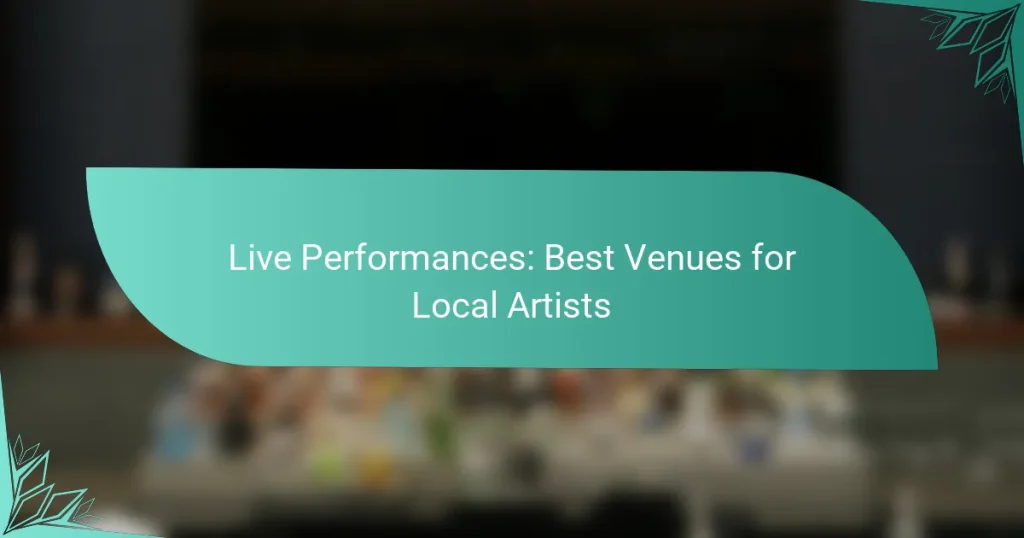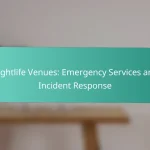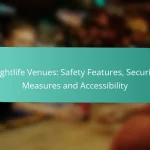Los Angeles boasts a dynamic landscape for local artists, featuring venues that embrace a variety of musical genres and cater to diverse audiences. These top venues not only offer a stage for performances but also foster a nurturing environment for emerging talent, making them essential for artists looking to make their mark.
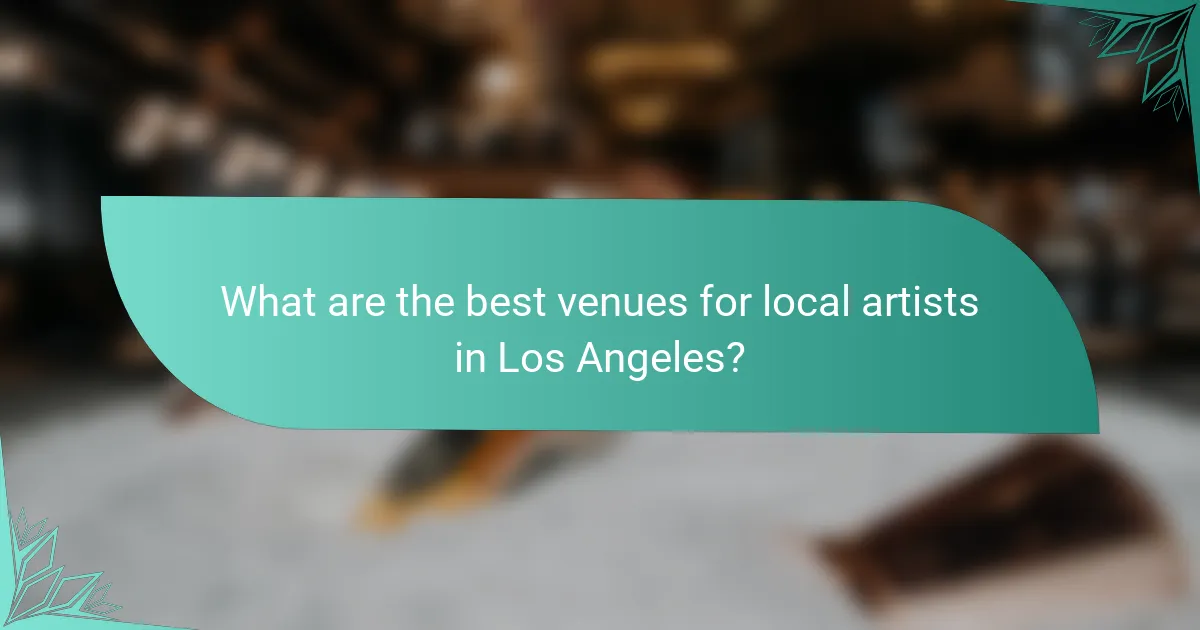
What are the best venues for local artists in Los Angeles?
Los Angeles offers a vibrant scene for local artists, with venues that cater to various genres and audiences. The best venues provide not only a platform for performance but also a supportive environment for emerging talent.
The Echo
The Echo is a well-known venue in Echo Park, celebrated for its intimate atmosphere and diverse lineup. It primarily features indie rock and electronic music, making it a hotspot for local artists looking to connect with audiences in a cozy setting.
With a capacity of around 350, The Echo allows for close interaction between performers and attendees. Artists should consider booking early, as slots can fill quickly, especially during weekends.
Hollywood Bowl
The Hollywood Bowl is an iconic outdoor amphitheater that hosts a variety of performances, from classical concerts to contemporary music. While it primarily features larger acts, local artists can participate in events like the Bowl’s summer concert series, which often includes community showcases.
Artists interested in performing here should keep an eye on submission deadlines for special events. The venue’s capacity exceeds 17,000, providing a unique opportunity for exposure to large audiences.
The Troubadour
The Troubadour is a legendary venue in West Hollywood, known for its rich history and support of up-and-coming artists. With a capacity of about 500, it offers a more personal experience while still attracting notable talent.
Local artists should prepare for a competitive booking process, as many famous musicians have launched their careers here. Networking and attending shows can help artists gain visibility and potentially secure a performance slot.
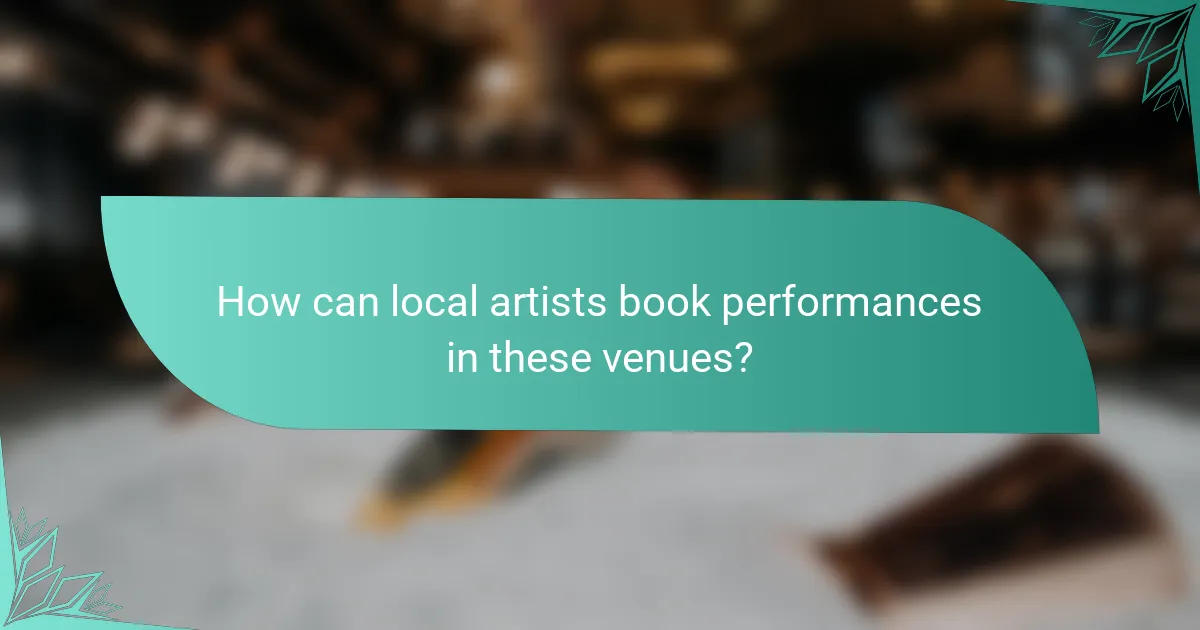
How can local artists book performances in these venues?
Local artists can book performances in venues by directly contacting venue management or utilizing online booking platforms. Understanding the specific requirements and processes for each method is essential for securing a performance slot.
Contacting venue management
To book a performance, artists should first identify the venues that align with their music style and audience. Once selected, reaching out to venue management via email or phone is crucial. Prepare a professional pitch that includes a brief bio, links to music samples, and any previous performance experience.
When contacting management, be clear about your availability and any specific needs, such as sound equipment or stage setup. Follow up politely if you don’t receive a response within a week or two, as venues often receive numerous inquiries.
Using booking platforms
Booking platforms can simplify the process for local artists looking to secure performance slots. Websites like GigSalad, Bandsintown, or ReverbNation allow artists to create profiles and list their availability, making it easier for venue owners to find and book them.
When using these platforms, ensure your profile is complete with high-quality images, music samples, and a compelling description. Regularly check for opportunities and respond promptly to booking requests to increase your chances of securing gigs.
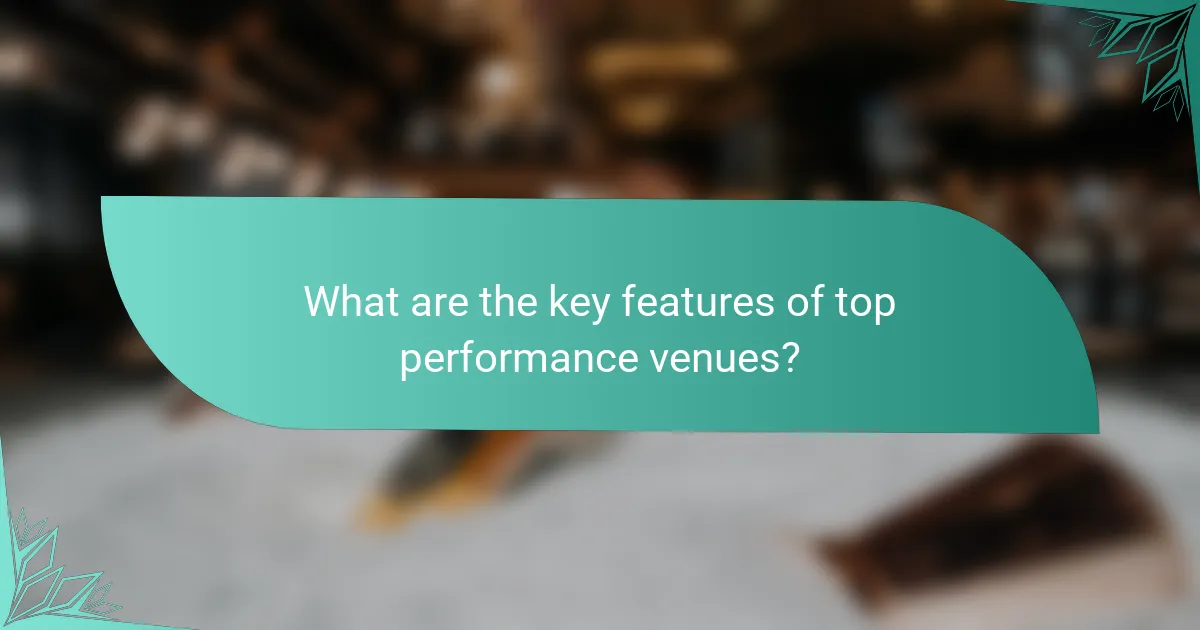
What are the key features of top performance venues?
Top performance venues are characterized by their capacity, acoustics, location, and accessibility. These features are crucial for ensuring a successful experience for both artists and audiences, impacting everything from sound quality to convenience.
Capacity and acoustics
Capacity refers to the number of attendees a venue can accommodate, which can range from intimate settings for a few dozen to large arenas hosting thousands. A venue’s acoustics play a vital role in sound quality, influencing how music and performances are experienced. Venues should ideally have a balance of size and sound design to enhance the audience’s experience.
When selecting a venue, consider the type of performance and expected audience size. For smaller acts, a venue with a capacity of 100-300 may provide a more personal atmosphere, while larger performances might require spaces that hold 1,000 or more. Additionally, venues with adjustable acoustics can cater to different genres, ensuring optimal sound for each performance.
Location and accessibility
Location is critical for attracting audiences, as venues situated in vibrant, easily accessible areas tend to draw larger crowds. Consider proximity to public transportation, parking availability, and local amenities that can enhance the overall experience for attendees. Venues in urban centers often benefit from higher foot traffic and visibility.
Accessibility is equally important, ensuring that all attendees, including those with disabilities, can comfortably reach and enjoy the venue. Look for venues that comply with local regulations regarding accessibility, such as ramps, elevators, and designated seating. A venue that is easy to access can significantly increase attendance and overall satisfaction.
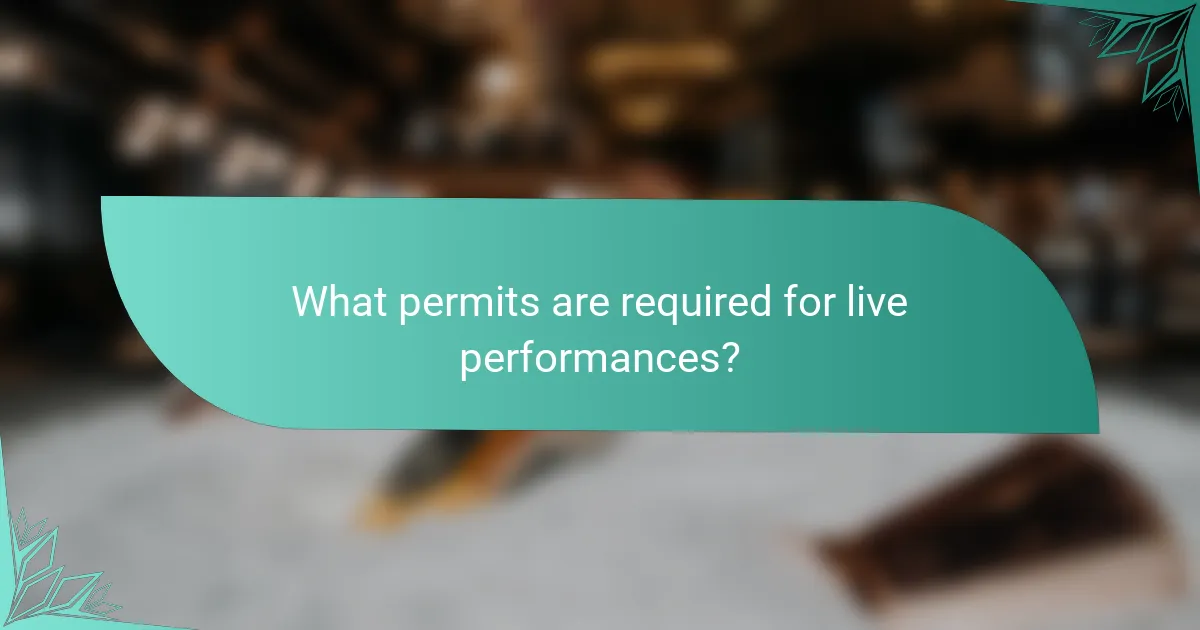
What permits are required for live performances?
Live performances typically require various permits to ensure compliance with local regulations. These permits can include event permits, noise permits, and other specific licenses depending on the venue and type of performance.
Event permits in Los Angeles
In Los Angeles, event permits are essential for hosting live performances in public spaces or venues. These permits are issued by the city and may require an application process that includes details about the event, expected attendance, and location.
To obtain an event permit, artists or organizers should apply at least several weeks in advance. Fees can vary based on the size and nature of the event, typically ranging from a few hundred to several thousand dollars. It’s crucial to check with the local city office for specific requirements and timelines.
Noise permits
Noise permits are often necessary for live performances that generate significant sound levels, especially in residential areas. In Los Angeles, these permits help regulate noise to minimize disturbances to the community.
To secure a noise permit, applicants must demonstrate how they will manage sound levels and comply with local noise ordinances. This may include using sound barriers or limiting performance hours. Failure to obtain a noise permit can result in fines or cancellation of the event, so it’s advisable to address this aspect early in the planning process.

What is the typical pricing structure for venue rentals?
The pricing structure for venue rentals can vary significantly based on location, size, and type of event. Generally, venues offer two main pricing models: hourly rates and flat fees for events, which cater to different needs and budgets.
Hourly rates
Hourly rates are commonly used for smaller events or when the rental duration is flexible. These rates can range from around $50 to $500 per hour, depending on the venue’s amenities and location. For example, a local community center may charge lower rates compared to a downtown theater.
When considering hourly rentals, it’s crucial to account for additional costs such as staffing, equipment rentals, and cleaning fees. Always clarify what is included in the hourly rate to avoid unexpected expenses.
Flat fees for events
Flat fees are often preferred for larger events, providing a clear total cost regardless of the duration. These fees can range from a few hundred to several thousand dollars, influenced by factors like the venue’s capacity and the day of the week. For instance, weekend events typically incur higher flat fees compared to weekdays.
When negotiating flat fees, inquire about included services such as sound equipment, lighting, and catering options. Understanding what is bundled in the price can help you make a more informed decision and stay within budget.
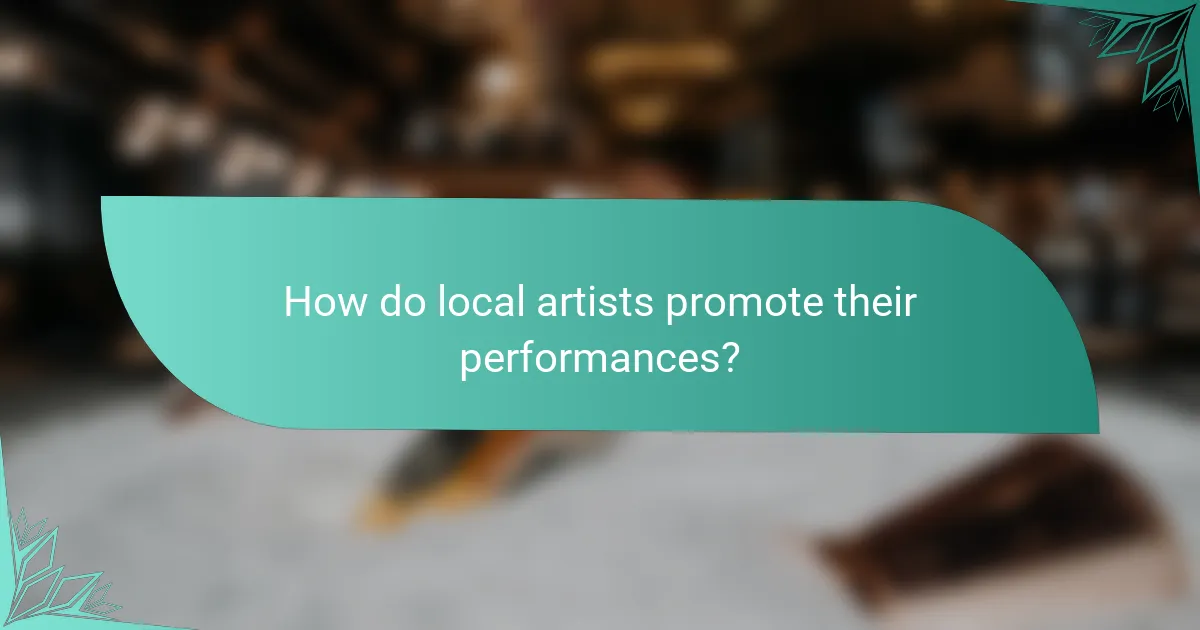
How do local artists promote their performances?
Local artists promote their performances through various strategies that enhance visibility and engagement. Effective promotion often combines digital outreach, community connections, and collaborations to attract audiences.
Social media marketing
Social media marketing is a vital tool for local artists to reach potential audiences. Platforms like Instagram, Facebook, and TikTok allow artists to share updates, behind-the-scenes content, and event announcements, making it easier to connect with fans.
To maximize impact, artists should post regularly, engage with followers, and use relevant hashtags. A well-planned content calendar can help maintain consistency and keep the audience informed about upcoming shows.
Collaborations with local influencers
Collaborating with local influencers can significantly boost an artist’s visibility. Influencers often have established audiences that trust their recommendations, making them valuable allies in promoting performances.
Artists should identify influencers whose brand aligns with their music or performance style. Offering free tickets or exclusive content can incentivize influencers to share the event, creating a win-win situation for both parties.
